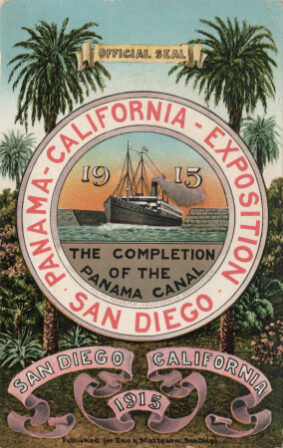Balboa Park and the Panama Canal Exposition Then and Now (PART 1)
In February Nancy Carol Carter entertained the Mission Hills Garden Club with a colorful and fascinating talk about “Growing Balboa Park.” Carter is well qualified. She is a horticultural historian who publishes and speaks on topics including the development of Balboa Park, San Diego gardens, the olive industry and the contributions of Kate O. Sessions and other significant California horticulturists. She also serves on myriad committees dealing with parks and horticulture and more.
Carter began with the early years: the park was founded in 1868. At that time San Diego was “land rich.” Alonzo Horton had acquired 960 acres of it in 1867. Horton, Ephraim Morse, and others considered setting aside some of this land for a city park. Morse suggested the park be contained by 6th and 28th Streets to the west and east and Ash and Upas at the south and north. This was about 1440 acres. In these early days, some of this land had been eroded by people with ulterior motives. Before this was approved, Isabella Carruthers took a “40 acre bite” for her home.
In 1870 a brand new Chamber of Commerce and the California legislature set aside 1400 acres of the city’s land that would be held in trust as free and public land. At that time, it was chaparral and some wild flowers. “Land sharks were aggressively circling” according to Carter , and they wanted to repeal the 1870 law, but San Diego citizens, without the aid of the Internet or Twitter, quickly got a petition and stopped them. Meanwhile an animal shelter for stray horses and cattle that were running loose on city streets occupied some of the land. A high school (now San Diego High) was built on another portion of the land. A dairy farm, Milk Ranch, was housed on this tract. Various charities took over more land including a home for indigent women, a training school for homeless boys, an old folks’ home as well as other projects.
San Diego citizens’ efforts led to various improvements: a Ladies’ Annex, tree clubs, and a golf course was an early fixture with oiled dirt in lieu of greens. An attempt to beautify 6th Avenue with benches was thwarted by vandals. Some people planted gardens. Ephraim Morse had always been interested in planting the park. In 1892 Kate Sessions leased 30 acres for a nursery. Her rent was to plant 100 trees a year. She created a demonstration garden, and a comprehensive plan for “Golden Hill Park,” the southern portion of the park. Sessions brought many plants from other parts of the world with similar climates to that of San Diego.
George Marston, Kate Sessions and Moses Luce formed a Chamber of Commerce Park Improvement Committee. They wanted to hire a landscape architect to enhance the park. Mary Coulson, a writer with expertise in gardens and forests suggested hiring Samuel Parsons, Jr. of New York. He worked from 1902 to 1905 on the park. George Marston paid him “from his own pocket.” Parsons wanted a place to promote mental health. He felt buildings would be superfluous; the park should be an alternative to city life. The park’s site opened on beautiful vistas of the ocean, the city, and the mountains. He advocated avoiding duplicating London’s or New York’s parks. He wanted more water dependent plants grouped together. The soil of our park was much like our home soil. To enable plowing it and making it fit for planting, dynamite was used to blow up the soil into workable chunks of dirt. No wonder it’s so hard to plant anything in our natural soil! We all need dynamite for gardening.
Next month I will finish the synopsis of Carter’s talk.
The May 27 meeting will be from 6 to 8 p.m. at 4070 Jackdaw Street.
Category: Local News








